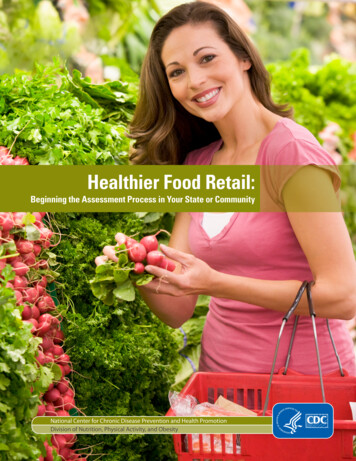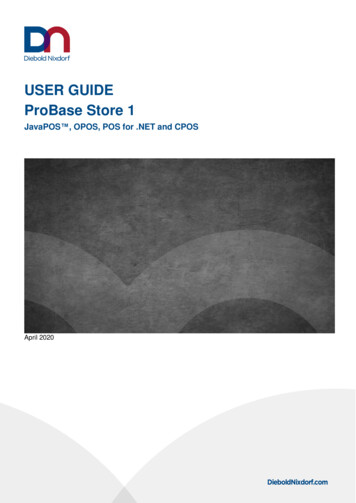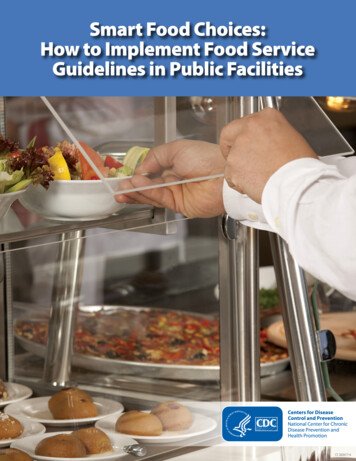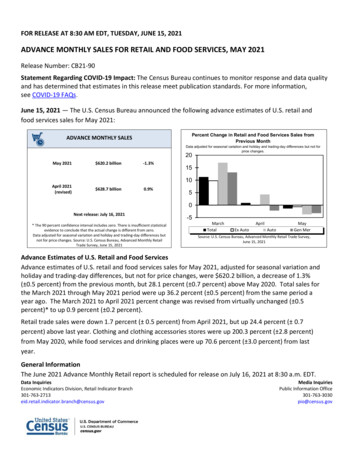
Transcription
Healthier Food Retail:Beginning the Assessment Process in Your State or CommunityNational Center for Chronic Disease Prevention and Health PromotionDivision of Nutrition, Physical Activity, and Obesity
Suggested Citation:Centers for Disease Control and Prevention. Healthier Food Retail: Beginning the AssessmentProcess in Your State or Community. Atlanta: U.S. Department of Health and HumanServices; 2014.Links to non-federal government organizations found in this document are provided solely as a service to the reader. Theselinks do not constitute an endorsement of these organizations or their programs by CDC or the federal government, andnone should be inferred. CDC is not responsible for the content of the individual organization sites listed in this document.
IntroductionAssessment of the food retail environment is part of a comprehensive approach toundertaking healthier food retail initiatives. This document provides public healthpractitioners with an overview of how to develop an assessment of their state’s orcommunity’s food retail environment through focusing, planning, and implementing theassessment and communicating the findings.Successful healthier food retail efforts depend upon reliable information on the food retailenvironment. Before implementing strategies to improve healthier food retail in your state orcommunity, it is necessary to assess the food retail environment to understand the extent andnature of the problem, including disparities to accessing affordable nutritious foods. Assessmentscan be tailored to address specific questions and can include topics such as identifying thenumber of stores in a given location, the types of food items sold in stores, or the types ofmarketing approaches that stores employ. The information gained from assessments can be usedto prioritize or plan healthier food retail strategies with partners or inform decision-makers whereinterventions may be warranted.When collecting data, make sure you follow local and federal polices related to data collectionincluding those related to privacy and research when applicable.Defining Healthier Food RetailIncreasing access to healthier foods and beverages through the establishment of orimprovements to food retail venues is the goal of healthier food retail strategies. TheDietary Guidelines for Americans, 2010 may be used to develop definitions for healthier foods.Generally, healthier foods will include fruits, vegetables, whole grains, fat-free and low-fatdairy products, and seafood, as well as foods with less sodium (salt), saturated fats, trans fats,cholesterol, added sugars, and refined grains. Healthier beverages include fat-free or low-fatmilk and milk products, fortified soy beverages and other lactose-free products, 100% juice,and water.Healthier Food Retail: Beginning the Assessment Process in Your State or Community1
Importance of a Healthier Food Retail EnvironmentThe United States Department of Agriculture (USDA) estimates that nearly 30 million Americans livein neighborhoods without easy access to affordable nutritious food,1 and persons living in lowerincome communities, communities of color, or rural communities are less likely to have healthierfood available to them.2 Making affordable, healthier foods more available to underserved residentsis one of several strategies that may help individuals to make healthier choices about what toeat and may be associated with better health outcomes. For example, research has shown thatresidents with access to full service grocery stores tend to eat more fruits and vegetables,2-7 andother studies have found an association between healthier food retail access and lower prevalenceof overweight and obesity among adults.8-12 However, these relationships have not been found insome studies.2,13 Conversely, the prevalence of overweight and obesity is higher in areas where foodis mostly available through small stores and fast food outlets.2,9,14Action Steps for AssessmentThe assessment of healthier food retail can be divided into four action steps for public healthpractitioners: 1) focus the assessment, 2) plan the assessment, 3) implement the assessment, and4) synthesize and report assessment findings.Action Step 1: Focus the AssessmentFocus your assessment by first defining terminology. You can then determine specific objectivesand questions about what you are trying to learn.Define variables. In focusing your healthier food retail assessment, you will want todetermine which types of retail venues you are working with and how you will defineAvailability and AccessibilityAvailability most often refers to the physical location orproximity of food retail outlets to residential areas, for exampleif a neighborhood has or is close to a grocery store. Sometimesthe term is also used to describe the presence of healthierfoods within stores, for example whether a not a small storesells fruits, vegetables, whole grains, and other healthier items.Accessibility is a broader concept that includes availability aswell as the selection, cost (affordability), and quality of foods.Healthier food options may be available, but if the pricesof those foods are beyond the customers’ budgets or if theselection or quality of the foods is inadequate (for example,limited varieties, spoiled produce, or expired dairy products),then the healthier foods are not accessible.2Healthier Food Retail: Beginning the Assessment Process in Your State or Community
healthier foods. You may also want to clarify how you are using the terms availability andaccessibility for your initiative.Deciding how you will define underserved areas and populations is an important step in focusingyour assessment. In healthier food retail, communities are often defined as underserved if theydo not have access to healthier foods in close proximity to their homes. This definition can berefined by adding characteristics, such as community impoverishment or lack of transportation tohealthier food retail outlets. Specific indicators include: Distance from where people live to the nearest supermarket or grocery store. The USDAdefines “low-access” communities as those where at least 500 residents or one-third of thearea’s population live more than one mile in urban areas or ten miles in rural areas to thenearest supermarket or large grocery store.15 Although this definition is commonly used todefine underserved communities, the distances may be changed to reflect the context ofyour community. For example, you may increase or decrease this distance as appropriate forareas with very low or very high population density. The mode of transport (e.g., on foot, bybus, by car) used to traverse the distance can complicate your definition. Low-income or poverty status. Different agencies and organizations define low-income orpoverty in different ways. For example, the U.S. Census Bureau provides income thresholdsthat vary by family size and ages of family members to determine who is in poverty,16 whichis used primarily for statistical purposes, while the U.S. Department of Health and HumanServices (HHS) provides poverty guidelines, which are a simplified version of the CensusBureau’s poverty thresholds and are used primarily for administrative purposes.17 Household vehicle ownership. Access to healthier food options is dependent on having ameans of transportation. Reviewing the number of households with or without access to avehicle is useful for determining populations that have very limited access to healthier foodretail stores.18 Ratio of food retailers with less healthy options to healthier food retailers. Poor access tohealthier foods may be defined by considering the presence of food retailers who generallyoffer fewer healthy options in comparison to the presence of healthier food retailers. Oneindicator for this concept is the Modified Retail Food Environment Index (mRFEI). For moreinformation on the mRFEI, see CDC’s Children’s Food Environment State Indicator Report, 2011 andaccompanying documents, available at Determine assessment objectives and questions. It is important to consider why you areconducting a healthier food retail assessment, what you hope to learn from the assessment,and how the assessment will be used. For example, you may want to determine healthier foodretail availability in either low-income, urban areas around your state or in rural areas, dependingon priorities, resources, or areas of greatest need. A resulting objective could be: “Determinewhere disparities exist in the availability and affordability of healthier foods and beverages forrural residents in the Northwest region of our state.” Examining information currently availableand easily accessible in your state (see Table 1, Public Data Sets for Healthier Food RetailAssessment) may provide a preliminary overview of the food retail environment and the contextfor determining your assessment objectives.Healthier Food Retail: Beginning the Assessment Process in Your State or Community3
After laying out the objectives for your assessment, draft a set of specific questions to answer.These questions will help you focus and plan your assessment. Keep the number of questionsmanageable for you and your partners.Specific assessment questions could include: On average, how far do residents in low-income, urban areas have to walk to get tosupermarkets or grocery stores that sell healthier food options, such as fruits and vegetables,whole grains, and low-fat dairy? What percentage of the state’s farmers markets accept or participate in federal foodassistance programs, such as Electronic Benefits Transfer (EBT) cards for the SupplementalNutrition Assistance Program (SNAP) and the Special Supplemental Nutrition Program forWomen, Infants, and Children (WIC)? How interested are specific underserved communities in having access to healthier foodretailers? Will other resources be needed to encourage purchasing and consumption ifavailability increases? Are there existing state policies that support or incentivize healthier food retail activities? How much fresh produce and other healthier food items do local small stores carry, and whatare the different options available in those stores?4Healthier Food Retail: Beginning the Assessment Process in Your State or Community
Action Step 2: Plan the AssessmentHealthier food retail can be assessed in many ways. You may analyze existing data or you maycollect new data, often through direct assessments of food retail venues or in-store inventoriesof healthier food. Additionally, Geographic Information System (GIS) mapping is a tool oftenused in healthier food retail assessment to provide a visual display of your data. These optionsare presented below, each of which can help you develop a better picture of healthier foodretail in your state.When developing your assessment plan, consider the benefits and limitations of differentmethods, as well as the feasibility for conducting the assessment. You can use the questionsbelow to guide your plan: Do you have existing data that can be used to answer your assessment questions or will youneed to collect data?»» What are your available time and resources for data analysis and collection? How will partners be involved in completing the assessment?»» Do your partners have access to needed data or do they have specific skills that cancontribute to the assessment effort? What methods will you use to assess the food retail environment?»» What indicators will you apply to measure the retail food environment?»» Have assessment tools been validated* and are they reliable†? How will data be systematically collected?»» How will data collectors be trained? What analyses are needed to answer your questions about food access?»» Will mapping or GIS be used to visually depict your food retail environment?»» What other technology or software analysis programs will be used to analyze data? How will assessment findings be synthesized and shared with stakeholders?Accessing existing data. Public and commercial data sets are available for assessment of yourstate or community food retail environment, and data can be combined from multiple sources.Data sets may focus on one or multiple types of retail locations (e.g., supermarkets, corner stores,or farmers markets) and may vary by measurements (e.g., proximity to grocery stores or numberof farmers markets).Data sets may vary by geographic area. A description of common geographic levels of data isprovided below. County level data. Many publicly accessible data sets are available at the county level.Although county level data may help states identify areas of potential need, counties are*Validity is concerned with the accuracy of measurement and whether what is being measured is what is intended.†Reliability is the extent to which a measure can be expected to produce similar results on repeated observations of the same conditionor event.Healthier Food Retail: Beginning the Assessment Process in Your State or Community5
often relatively large and include diverse geographic areas. Thus, your ability to determinecommunity-level differences in underserved areas may be obscured when data areaggregated at the county level. In addition, some data are available for a metropolitanstatistical area, which is a geographic region of one or more counties that represents anurban area.19 ZIP code level data. ZIP code level data are sometimes publicly available. Although ZIP codesare designed for mail delivery purposes, they may be informative to states in getting a broadoverview of their retail food landscape. However, they encompass a larger area than what istraditionally considered a neighborhood. Data at census tract, census block group, and census block levels. These data have servedas proxies for neighborhoods. Census tracts are designed to be homogenous in termsof population and economic characteristics, with block groups and block levels beingsubdivisions of tracts. Data at the census tract level and below provide local informationabout retail venues that may be easily accessible. Address level (Geocoded) data. These data provide a specific location for a retail store,identified by address or geographic coordinates. It is the most detailed level of data that youcan access, but may need to be purchased from commercial companies. This type of data isdepicted as a point on a map with no associated geographic area. It allows the user to definegeographic boundaries that are context specific.Important considerations for using different levels of the data include: Size of geographic unit. The larger the geographic unit, the more the collective data maymask differences within that unit, making it difficult to determine where the underservedpopulations are. Boundaries of geographic unit. The boundaries of geographic units do not alwayscorrespond to shopping patterns. Creating buffer zones around specific stores may helpapproximate a more accurate shopping area. With address level store data, you can createyour own boundaries. Application in state or community assessments. If you are doing a state-level assessment,you may want to first look at county-level or other large geographic unit data to get abroader view of healthier food retail. You can then map some regions or cities within thestate in more detail as needed. The smaller geographic units can still be valuable forstate-level assessment, as they can help you identify specific areas with the greatest needand allow you to see regional differences within the state that may not be captured bybroader levels of data.Public data sets. Public data sets are free of charge and can help give a good initial pictureof what is happening in a state related to healthier food retail. Table 1, Public Data Sets forHealthier Food Retail Assessment, presents examples of public data sets that can be used toassess general food retail.6Healthier Food Retail: Beginning the Assessment Process in Your State or Community
Table 1. Public Data Sets for Healthier Food Retail AssessmentData SetUnited States Department of Agriculture (USDA)Food Environment vironmentatlas.aspxThe Food Environment Atlas provides food environmentindicators to examine factors related to food choices and dietquality. It also provides an overview of a community’s abilityto access healthier food. USDA’s Food Environment Atlas hasover 160 indicators that are related to the food environment,including indicators on health and well-being, and communitycharacteristics. Regarding retail, the Food Environment Atlasprovides indicators in the areas of access and proximity togrocery stores, availability of food stores, and local foods.USDA Food Access Research cess-researchatlas.aspxThe Food Desert Research Atlas uses a map of the entireUnited States to show the census tracts in the nation that arefood deserts based on multiple indicators of food access. TheUSDA also has a related Web site discussing food deserts andtheir identification, available at spx.Retail TypeData LevelSupermarkets or large grocery Statestores; supercenters or club Regionstores; convenience stores; Countyfarmers marketsSupermarkets or largegrocery stores Census tractCenters for Disease Control and Prevention ModifiedRetail Food Environment Index (mRFEI) Data TableHealthy food retailers include Census tractsupermarkets, larger grocerystores, supercenters, mlproduce stores as defined byThe mRFEI measures the number of healthy and less healthythe North American Industryfood retailers within census tracts across each state as definedClassification System (NAICS).by typical food offerings in specific types of retail stores (e.g.,Less healthy food retailerssupermarkets, convenience stores, or fast food restaurants).include fast food restaurants,States and communities can use these data to create mapssmall grocery stores, andusing GIS software or link the mRFEI data to other census-tractconvenience stores as definedlevel data they may have available.by the NAICS.ArcGIS Food Deserts Groupwww.arcgis.com/home/group.html?owner jimhe&title Food%20DesertsThis is a mapping and GIS users group established by Esri,the company that produces the ArcGIS software, dedicatedto food deserts and food access in the United States. Theresources of particular importance are the Supermarket AccessMap and the Food Environment Explorer, which offer detailedinformation regarding supermarket location in relation todriving and walking access. These maps also facilitate overlayof health-related information regarding diabetes and obesityon the food access map.Supermarkets and food Countyoutlets (defined as all grocery Census block groupstores as well as produce Addressstands or farmers markets)ContinuedHealthier Food Retail: Beginning the Assessment Process in Your State or Community7
Data SetCounty Health Rankingswww.countyhealthrankings.orgThis database ranks each county within the 50 states accordingto its health outcomes and the multiple health factors thatdetermine a county’s health. The county health rankings havean indicator under the “built environment” section called “accessto healthier food.”Policy Map, from The Reinvestment Fundhttp://www.policymap.com/mapsPolicy Map offers on-line mapping capabilities based onmore than 10,000 indicators related to demographics, realestate, city crime rates, health, schools, housing affordability,employment, energy, and public investments. It includesdata available from a supermarket study on food access;a subset of the data is available for free. A subscription isrequired for detailed information.United States Census Bureau’s County andZIP Code Business Patternswww.census.gov/econ/cbp/index.htmlThe U.S. Census Business Patterns data provides the numberof establishments, number of employees, and payroll databy industry, according to the 2007 NAICS. These data can beemployed to track which ZIP codes, metropolitan areas, andcounties have retailers located within their boundaries.Community ommunity Commons uses a Web-based GIS, developedand implemented by the Center for Applied Research andEnvironmental Systems (CARES) at the University of Missouri.The site provides open access to over 7,000 national GIS datalayers, which include socioeconomic and demographic (Census/American Community Survey), health, education, political, andenvironmental data.8Retail TypeData LevelHealthier food outlets(defined as all grocery storesas well as produce stands orfarmers markets) CountySupermarkets and otherbusiness establishments,as defined by the NAICS State Metropolitan statistical area County City Census tract Census block groupVarious businessestablishments, as definedby the NAICS State Metropolitan statistical area County ZIP codeGrocers, supermarkets,and other businessestablishments, asdefined by the NAICS,farmers markets State Congressional district County ZIP code AddressHealthier Food Retail: Beginning the Assessment Process in Your State or Community
Commercial data sets. You may also want to consider commercial sources of data for yourassessment. Commercial data directories can be purchased that identify the address andgeographic coordinates of various types of retail stores, including food stores. Some commonlyused commercial data sets include: Dun & Bradstreet, Inc. InfoUSA, Inc. Nielsen Trade Dimensions (TDLinx)Data set limits. Public and commercial data sets are important for understanding the food retailenvironment; however, they have several limitations: Commercial data sets may be prohibitively expensive depending on the size of the areabeing studied. Commercial data sets are proprietary; therefore, companies provide only general informationon how the data were collected and verified. Public and commercial data sets can have a time lag from when the data were collected towhen the data are obtained and used. Public and commercial data sets can have data validity concerns, including issues withaccurate geocoding, potentially resulting in over counting or undercounting of stores andmisclassification of store types.20,21Combining several of the data sets from different companies or public data sources improvesaccuracy but can be labor intensive and costly. For these reasons, it may be more feasible tocollaborate with partners who have purchased data already. Although they will not be able togive you the data, they may be able to work with you on projects or analyze the data sets for you.These large commercial and public data sets generally do not describe the number or type ofhealthier food options available in the retailer venue, although it is often assumed that certaintypes of retailers offer or do not offer healthier foods. To more fully understand what healthierfood is available for a community within the retail locations, direct assessments are necessary (seeConducting Direct Assessments section below).Working with partners. As you explore ideas for data sets to use, don’t forget to ask partners forcreative solutions to answer questions or to gain access to restricted data. State or local departments of health or agriculture. Other divisions within the state healthdepartment or county health departments may collect food store data to comply with foodsafety regulations or inform decisions in their locales. State departments of agriculture mayalso have food retail data. Offices for WIC and SNAP. WIC and SNAP partners may have data on the number and type offood retail stores in the state that participate in nutrition benefit programs, which indicatewhere low-income residents have healthier food retail access and to what extent thosebenefits are being used. With recent changes to the WIC minimum stocking requirements,WIC-approved stores are now required to carry a certain amount of healthier foods.22 Yourstate’s offices for WIC and SNAP benefits may have listings of all WIC- and SNAP-approvedHealthier Food Retail: Beginning the Assessment Process in Your State or Community9
stores. If those listings are not available, the federal SNAP Web site (http://www.fns.usda.gov/snap/) has a retail locator program that maps the closest SNAP-approved stores to agiven address and the USDA Food Environment Atlas (see Table 1, Public Data Sets forHealthier Food Retail Assessment) includes multiple county-level measures about WIC andSNAP, including authorized stores and redemption rates.Conducting direct assessments. You may want to use direct observation of retail venues or instore inventory audits to fully understand healthier food retail access in your state or community.Direct observation of food retail locations can be used to ensure comprehensive and up-to-datedata. For example, there may be stores that have recently opened or closed. Since many data setsmay not have recently updated data, they may not accurately represent the current food retaillandscape. Additionally, direct assessments can be used to examine the existence of healthierfoods inside a store, the affordability of the healthier foods, or the presence of in-store marketing,among other measures. They can also be used to assess venues not typically included in public orcommercial data such as mobile retail vendors or roadside stands.Assessments by direct observation can be important for planning local activities or strategies.However, they are resource intensive on a statewide level and are thus more feasible at acommunity level. By supplementing your state level data using direct observation methods fora community or region, you will have more complete information for planning overall strategies.If you conduct multiple assessments or work in more than one area in your state, considercoordinating with partners to complete the localized assessments.10Healthier Food Retail: Beginning the Assessment Process in Your State or Community
Some validated instruments and methods have been developed for systematic direct observationor the on-site verification of store locations.23-26 The following assessments and tools areexamples of ways to look at availability, cost, and quality of healthier foods in your state. Market basket audits. These audits measure the food available within a store, and canevaluate cost and quality of the food among other measures. Two examples are:»» The Nutrition Environment Measures Survey for Stores includes measures for the type andlocation of food outlets, availability of healthier and less-healthy options, and pricing.Available at http://www.med.upenn.edu/nems/.»» The USDA Economic Research Service Food Store Survey Instrument is part of theCommunity Food Security Assessment Toolkit. It assesses the availability and affordability offood in retail outlets. Available at research-program/efan02013.aspx. Linear shelf space. This method measures the actual space expended on shelves for varioustypes of food in stores and compares the number of healthier food options and less healthyitems available for purchase. This is important because usage of shelf space can impact thebuying behavior of consumers. Shelf space measures can also help you understand howprominently the healthier food options are displayed compared to other options in the store.7»» The tool, Calculating Selling Area for Healthy Retail, from ChangeLab Solutions explainshow to measure the total selling area of a store, including floor area and shelf space.It also discusses how to calculate the total percentage of selling area being used forspecific products like produce or staple foods. Available at ting-selling-area. Marketing of healthier or less healthy items. An assessment can include measures of theamount of marketing or advertisements for healthier items and less healthy items in thestore, as well as placement of healthier or less healthy items near checkout.27 Store owner survey or interviews. Store owners can provide useful information about theproducts they carry and their customers’ purchasing habits. If the owner or store manager iswilling, you can review the store’s inventory lists or purchasing records can to obtain moreaccurate information on a store’s supply of healthier foods. Social and economic measures. You may want to consider assessing social and economicconcepts related to addressing food retail accessibility in your state. For example,www.marketumbrella.org has developed assessment tools that may help you assess healthierfood retail options from a farmers market vendor, customer, and community perspective.»» The Sticky Economic Evaluation Device (SEED) helps determine the economic impact that afarmers market can have on a community. This tool is available on-line.»» The Neighborhood Equity Evaluation Device (NEED) helps understand the social capitalthat a farmers market may bring to a community, and the Food Environment EvaluationDevice (FEED) helps consider the role of farmers markets in promoting health throughaccess to fresh fruits and vegetables and the farmers who grow them. Sample studiesusing these two tools are available on-line.Healthier Food Retail: Beginning the Assessment Process in Your State or Community11
An extensive list of surveys, interview protocols, and other measures that assess aspects ofavailability and affordability of healthier food options can be found in the following resources: The Measures Registry from the National Collaborative on Childhood Obesity Research(NCCOR). The Measures Registry is a searchable database of measures on diet and physicalactivity
dairy products, and seafood, as well as foods with less sodium (salt), saturated fats, trans fats, cholesterol, added sugars, and refined grains. Healthier beverages include fat-free or low-fat milk and milk products, fortified soy beverages and other lacto










